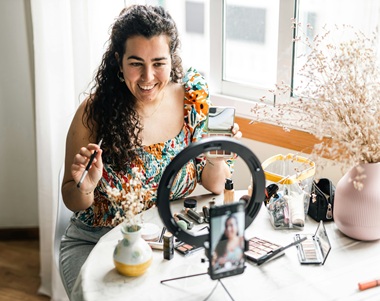
The stay-at-home girlfriends trend might illustrate the growing pains of figuring out what sustainable models of home-based work and care could look like.
The ‘stay-at-home girlfriend’ trend has become more than a TikTok aesthetic; it’s a flashpoint for bigger conversations about gender, money and identity in modern relationships.
The trend, most popular between 2022 and 2024, features mostly childless Gen Z women who stay at home keeping house while their boyfriends take care of the finances. The trend has sparked backlash, such as concerns over financial abuse or the glorification of female domesticity.
One early stay-at-home girlfriend influencer, Kendel Kay, gained attention for documenting her daily life, financially supported by her Canadian boyfriend, Luke. After their breakup, she described the challenges of having built her identity and content around that role. She’s since shifted her brand away from the trend.
Other accounts are now riffing off the stay-at-home girlfriend trend in more interesting ways – like Ontario couple William Conrad and Levi Coralynn. The two present a gender-reversed household where William quit his tech job to support Levi’s influencer business. He even has his own TikTok channel branding himself a stay-at-home boyfriend.
Yet beneath all the criticism and commentary, there’s still an undercurrent of resonance. Several writers have suggested that women are weary of the girl boss narrative they or their mothers once found so empowering.
For many women, carrying fewer financial responsibilities is appealing because it allows them to nurture various aspects of their environments in an integrated way. (By environments, I mean everything from friendships, immediate families and communities to personal habits and household routines.) In other words, each aspect of life, including work, fits into a holistic picture.
Most of the women (and many men) I know feel the tension between earning income and managing other responsibilities – especially if they have children. They have genuine desires for tranquility, stable relationships and freedom from the frenetic pace of our hustling culture. Often, jobs conflict with those values.
This may be why, when given the choice, many women opt for work that can be integrated into the rest of their lives. (Of course, flexible hours, working from home or not working at all simply aren’t options for many of us due to economic realities.)
And the stay-at-home girlfriend trend presents a fraught example of ‘staying at home.’ Content creators jumping on the trend often fill their feeds with advice on how to find a ‘high-value man’ and keep him happy – including extensive beauty routines. The lifestyle relies heavily on female beauty and male financial power. The value exchange is: ‘I will be beautiful if you will pay for everything.’
What’s often missing from these portrayals is a sense of larger purpose beyond personal ease – such as caring for children or aging parents, being involved in a local community, volunteering, pursuing education, passions or fulfilling work. Responsibilities like these expand our resilience and capacity to face hardship. They stretch our potential and cultivate maturity and virtue.
These relationships also don’t portray meaningful partnerships between men and women. Think about how couples’ work dynamics have changed over time. During the agrarian societies of most of human history, heterosexual households were economic units. Each partner contributed to the family’s survival. Tasks in the home were divided by practical need, with women often doing work like weaving and textile-making. This kind of flexible, home-based work fit well with childcare and managing other household responsibilities.
Stay-at-home girlfriend influencers have, in a way, brought economic value into their homes too (let’s not forget that being an influencer can lead to income). Unfortunately, their position is precarious. Without the legal protection of marriage or common law, they have limited or no rights to property or support if the relationship falls apart. And their brand is tied to their youth and beauty, making it unsustainable long-term.
Mary Harrington (author of Feminism Against Progress) raises a vital question: “What does a 21st century version of the premodern productive household look like?” Her question feels especially relevant for modern relationships.
Today’s work has shifted dramatically from what women and men did for centuries. The remote work transition precipitated by Covid has made jobs more flexible, creating more opportunities for caretakers, who are still largely women, to continue working alongside other home responsibilities.
For some women, a modern equivalent of weaving while caretaking or investing in her community is the ideal. For others, it is stifling. The labour arrangements will vary between couples, and across different life seasons.

Ilana Reimer
We’re still experiencing the growing pains of figuring out what sustainable models of home-based work and care could look like – especially for women who want to stay home with their children. The stay-at-home girlfriend trend might be one illustration of those growing pains. But any arrangement that lacks robust mutuality and commitment will become weak or unfulfilling for one or both partners.
Ilana Reimer has written for several publications, including Ekstasis, Comment, Breaking Ground, Faith Today and Mutuality. Her newsletter, Counterparts, reflects on gender, sexuality and human dignity. She grew up near Ottawa, Ontario and has recently begun a new adventure in Vancouver with her husband, Geoff.
She has posted this comment on this site as a member of The Bell: Diverse Christian Voices in Vancouver. Go here to see earlier comments in the series.
